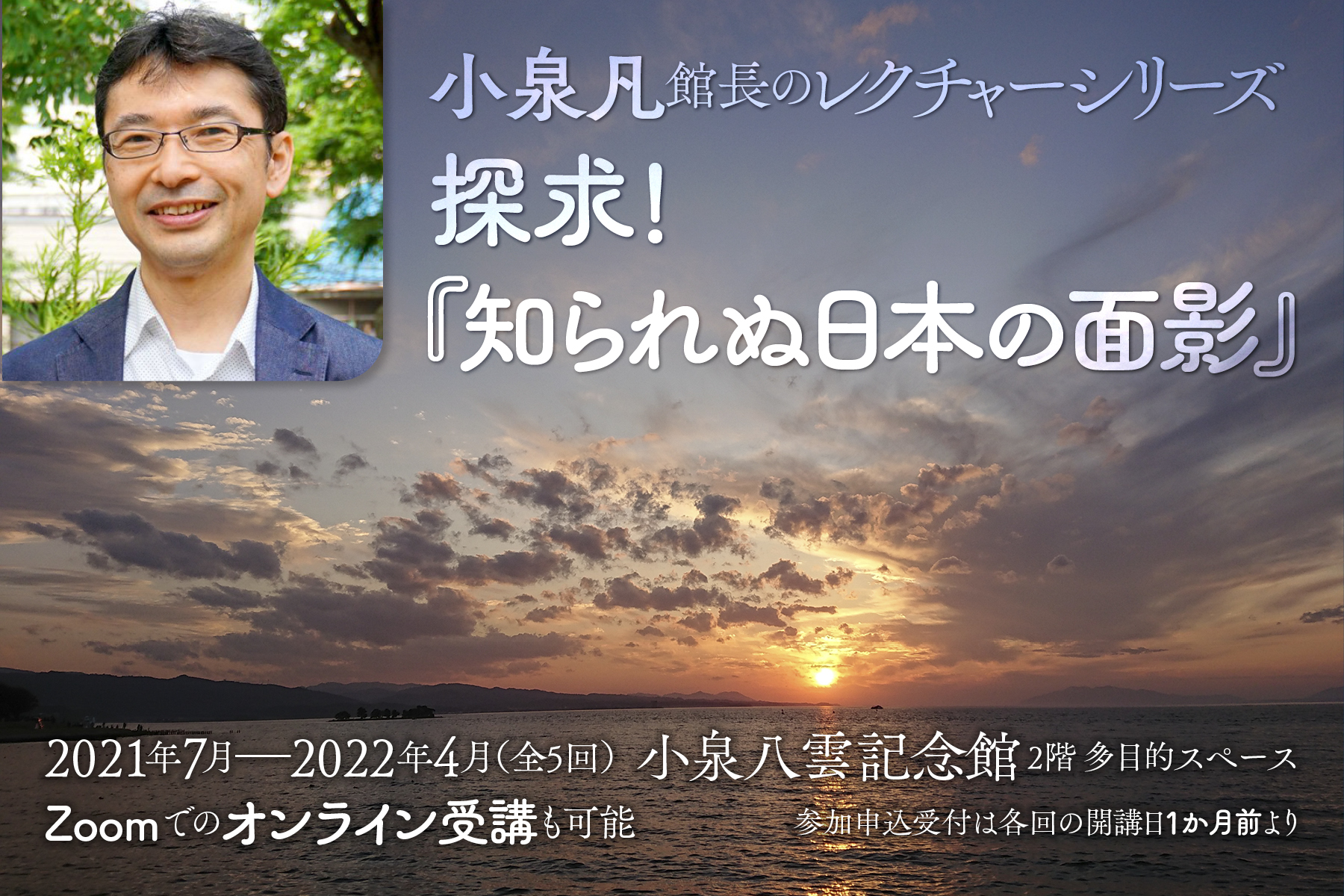企画展
神々の国の首都に住まふ443日
Exhibition
443 Days in The Chief City of the Province of the Gods
2021年6月27日(日)―2022年6月12日(日)
1階 展示室3
松江国際文化観光都市70年
主催:小泉八雲記念館
共催:松江市、山陰中央新報社
協力:島根県立図書館、島根大学附属図書館、松江市立中央図書館、松江歴史館
後援:八雲会、朝日新聞松江総局、共同通信社松江支局、産経新聞社、時事通信社松江支局、島根日日新聞社、中国新聞社、日本経済新聞社松江支局、毎日新聞松江支局、読売新聞松江支局、
BSS山陰放送、NHK松江放送局、TSKさんいん中央テレビ、日本海テレビ、山陰ケーブルビジョン、エフエムいずも、エフエム山陰
Sunday June 27, 2021–Sunday June 12, 2022
Exhibition Room 3
Commemoration of the 70th Anniversary of Matsue’s Designation as an International City of Culture and Tourism
organizer: Lafcadio Hearn Memorial Museum
co-organizers: Matsue City / The San-in Chuo Shimpo Newspaper Co., Ltd.
cooperation: Shimane Prefectural Library / Shimane University Library / Matsue City Central Library / Matsue History Museum
support: The Hearn Society / Asahi Shimbun Matsue office / Kyodo News Matsue office / Sankei Shimbun / Jiji Press Matsue office / Shimane Nichi-nichi Shimbun / Chugoku Shimbun / Nihon Keizai Shimbun Matsue office / Mainichi Shimbun Matsue office / Yomiuri Shimbun Matsue office / Broadcasting System of San-in Inc. / NHK Matsue / TSK Sanin Chuo TV / Nihonkai Telecasting Co., Ltd. / San-in Cable Vision / FM Izumo / FM San-in


松江にラフカディオ・ハーン(小泉八雲)が到着して130年余り。今もハーンが残した作品は世界中で読み継がれ、町には当時の面影と佇まいがかすかに残っています。
39歳で来日したハーンは、1890年8月30日に松江に到着し、この町を「神々の国の首都」と呼びました。来日後第1作目となる『知られぬ日本の面影』(1894)には、感動に溢れたみずみずしい文章で松江の風物とそこに住まう人々の印象が日記のように書きとめられています。「神々の国の首都」では、うつろう宍道湖の風景が絵画のように描写され、有名な冒頭部分では松江の朝の様子が「音」で綴られ、そして夜を迎えるまでの一日が映画のようにドラマティックに描出されています。さらに、英語教師としての生徒たちとの交流や、民俗学者のまなざしで観察した土地の民間信仰、俗信、怪談などが随所に織りこまれています。
同著は、いくつかの章を除いてほとんどが松江や出雲およびその周辺の紹介に費やされ、松江の暮らしはわずか443日という短い期間であったにもかかわらず、西洋優位の視点からではなく、相手に寄り添い、五感を研ぎ澄ませて日本人の心の内奥までくみとる鋭い直観力で深い洞察を行っています。私たちは、そこに現代の日本人が忘れかけた郷愁にも似た古き良き日本の姿を見ることができ、共感を持って現代社会を見つめ直すことができるのです。
ハーンが神々の国の首都を去った後も、その作品は松江に大きな足跡を残すことになります。1934年には、有志の努力により小泉八雲記念館が開館し、ハーンとセツが住んだ根岸邸(現・小泉八雲旧居)は、1940年に国の史跡指定を受けています。さらに、1951年、松江市は「ラフカディオ・ハーン(小泉八雲)の文筆を通して世界的に著名である」ことから京都や奈良と並んで国際文化観光都市に制定されました。2021年は制定70周年にあたります。
この企画展では、著書『知られぬ日本の面影』、ハーンの親友西田千太郎が残した日記、友人・知人に宛てた書簡類、当時の新聞、富田家秘蔵文書*、松江におけるハーンの私生活の聞き書き、教え子たちの追悼文などをたどりながら、ハーンが住まった443日間の記録を紐解いていき、6つの章からハーンが瞥見した日本の面影に迫ります。そしてそれを現代の視点で読み解き共有するために、展示と同時にSNSなどのオンライン上でのつぶやきを通して、ハーンのオープン・マインドに響き合う精神を探ってみたいと思います。まさに、時代がハーンを必要としている感じがしますが、ノスタルジックな文学として鑑賞するだけではなく、山陰の風土が放つ魅力やこの土地の持つポテンシャルを引き出して、文化資源として今後の観光や文化発信につないでいく一助となることを願うものです
*富田家は、ハーンが松江で最初に逗留した旅館
Lafcadio Hearn (Koizumi Yakumo) arrived in Matsue over 130 years ago. His works are still read around the world today, and in the city of Matsue, glimpses of his time here remain.
Hearn came to Japan at the age of 39 and arrived in Matsue on 30th August 1890. He called Matsue “The Chief City of the Province of the Gods”. His first work after his arrival in Japan was Glimpses of Unfamiliar Japan (1894). It overflows with rich impressions and reads like a diary which reflects the scenery and culture of Matsue, and the lives of its people. In “The Chief City of the Province of the Gods”, the changing views of Lake Shinji are depicted like visual images. The famous opening lines describe the sounds of a Matsue morning. His description of a day in the life of the city, from morning to evening, is dramatically expressed like a film. The work is interwoven with his interactions with his students of English, and the local folk beliefs, popular beliefs and ghost stories which he observed with the eyes of a folklorist.
Apart from a few passages, the work primarily introduces Matsue, Izumo and the surrounding areas. Hearn lived in Matsue for only 443 days, but he used his time and his highly developed five senses to observe, in depth and with an acute intuition, the innermost Japanese spirit. He studied the Japanese as they were, and not from a position of Western superiority. A modern reader of Glimpses of Unfamiliar Japan experiences nostalgia for the forgotten values of old Japan, but can also empathise with the issues of modern society.
Even after Hearn left the Chief City of the Province of the Gods, this work left an iconic legacy for the city. In 1934, thanks to the efforts of volunteers, the Lafcadio Hearn Memorial Museum was established. In 1940, the Negishi residence, where Hearn and his wife Setsu lived, (now identified as Lafcadio Hearn’s Former Residence), was nationally recognised as a Historical Site. In 1951, Matsue joined Kyoto and Nara in being designated as an International City of Culture and Tourism because it had become “globally famous through the works of Lafcadio Hearn”. The year 2021 marks the 70th anniversary of this designation.
This exhibition explores the 443 days Hearn spent in Matsue. The six sections use Glimpses of Unfamiliar Japan, the diary of Hearn’s friend Nishida Sentaro, letters to Hearn’s friends and acquaintances, newspapers of the time, treasured documents of the Tomita family*, interviews about Hearn’s private life in Matsue, and eulogies from his students, to examine his insight into the Japan of his time.
We also want to understand and share the exhibition’s findings from a modern perspective. So, during the term of the exhibition, we plan to communicate Hearn’s spirit, which resonates with his open mind, through online postings such as SNS, to people in Japan and overseas. This is an era, which truly needs Hearn. The exhibition is not merely focused on nostalgic literature. It also shows the appeal of the San’in region and its potential, and as a cultural resource, we hope it helps to lead to tourism and cultural communication in the future.
* Tomita was the first inn Hearn stayed at when he came to Matsue
展示テーマ
Exhibition Themes
- chapter 1 | 443 days in thchief city of the province of the gods
- chapter 2 | Reportage and travelogue
- chapter 3 | Scenery drawn by a word painter
- chapter 4 | The eyes and heart of a folklorist
- chapter 5 | Concept of a soundscape
- chapter 6 | Hearn’s life—teaching, marriage, interests, walking
- | Hearn postings on social media
#神々の国の首都443 #matsue443

小泉家蔵

Glimpses of Unfamiliar Japan, Houghton, Mifflin & Co., 1894
ハーン来日後初の著作。1890年8月、「神々の国の首都」松江にやって来たハーンは、そこで見聞した民衆の暮らしや風物をみずみずしい文体で描出している。全2巻
小泉八雲記念館蔵

西田日記にはハーンとの交友が細かく綴られている
島根県立図書館蔵

桑原は、ハーンの近くで世話をした女性2人へのインタビューをまとめて出版した
島根大学附属図書館蔵

横木は尋常中学校のハーンの教え子
小泉八雲記念館蔵

富田旅館女将
島根大学附属図書館蔵

富田太平・ツネによる口述筆記
小泉八雲記念館蔵

小泉八雲記念館蔵
今も残る日本の面影
Remaining Glimpses of Old Japan
Classic

松江歴史館蔵

松江歴史館蔵

バートン・ホームズ撮影。The Writings of Lafcadio Hearn, Houghton, Mifflin & Co., 1922 より転載

小泉八雲記念館蔵

『小泉八雲作品集』(恒文社、1964)より転載
Modern





参考文献
- Lafcadio Hearn, Glimpses of Unfamiliar Japan (Houghton, Mifflin & Co., 1894)
- 平井呈一訳『日本瞥見記』上・下(恒文社、1975)
- 平川祐弘編『明治日本の面影』(講談社学術文庫、1990)
- 平川祐弘編『神々の国の首都』(講談社学術文庫、1990)
- 池田雅之訳『新編 日本の面影』(角川ソフィア文庫、2000)
- 池田雅之訳『新編 日本の面影 II』(角川ソフィア文庫、2015)
- 『ラフカディオ・ハーン著作集』第14・15巻(恒文社、1983)
- 『西田千太郎日記』(島根郷土資料刊行会、1976)
- 根岸磐井『復刻版 出雲における小泉八雲』(今井出版、2016)
- 桑原羊次郎『松江に於ける八雲の私生活』(島根叢書、1950)
- 飯野公央・伊藤孝一・石倉舞美『写真でたどるハーンの1年2ヶ月』(江友、2013)
- 石村春荘『松江むかし話』(高浜印刷所、1964)
- 梶谷泰之『へるん先生生活記』(恒文社、1998)
- 常松正雄訳『ラフカディオ・ハーン 西田千太郎 往復書簡』(八雲会、2020)
- 「富田旅館ニ於ケル小泉八雲先生」(『古都松江』Vol.37、松江市文化協会、2019)
- 小泉凡『民俗学者・小泉八雲』(恒文社、1995)
- 牧野陽子『ラフカディオ・ハーンと日本の近代』(新曜社、2020)
- 池田雅之『小泉八雲 日本の面影』(NHK出版、2016)
- 坂東浩司『詳述年表 ラフカディオ・ハーン伝』(英潮社、1998)
- 『小泉八雲事典』(恒文社、2000)
- 工藤泰子「松江の文化資源としての小泉八雲」(『インバウンドと地域創生』、KAIBUNDO、2017)
- 小泉節子・小泉一雄『小泉八雲 思い出の記・父「八雲」を憶う』(恒文社、1976)
- 松浦雄二「『知られぬ日本の面影における「まぼろし系」の言葉」(『島根県立大学短期大学部松江キャンパス研究紀要』Vol.52、2014)





